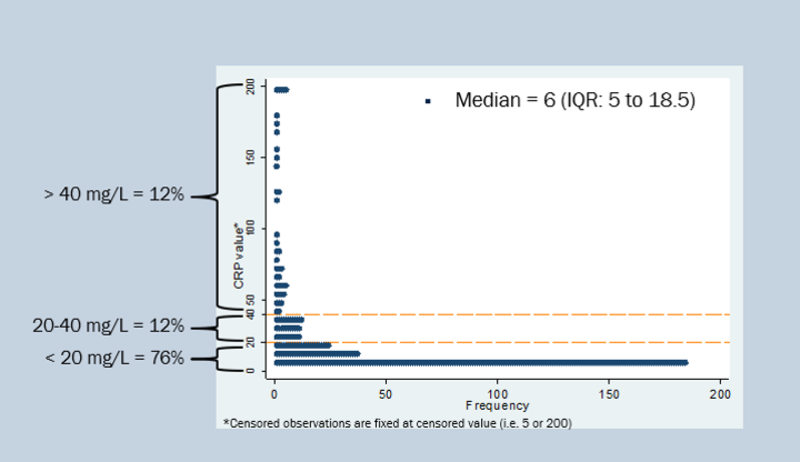Why use POC CRP tests?
How can POC CRP tests help you?
CRP is produced in the liver, increasing within 4 to 6 hours of the onset of inflammation or acute tissue injury and peaks at 36 to 90 hours (i.e. 1.5 to 4 days). CRP levels remain elevated with ongoing inflammation, but drop rapidly after their resolution because of its short half-life of 4 to 7 hours.
In uncomplicated infection the CRP value is usually below 10 mg/l after a week’s illness.
The NICE guideline (CG191 [24]) suggests that it can be used to assist and guide antibiotic prescribing decisions for lower RTIs.
Research evidence [1,19,26-28] also shows that it can help safely reduce antibiotic prescribing in primary care.
Evidence of benefits
It can help differentiate pneumonia from less severe infections and can help reduce clinical uncertainty when it is not clear whether antibiotics should be prescribed.
NICE Guideline (CG191) [24] recommends using it with patients presenting with lower RTI when, after clinical assessment, a diagnosis of pneumonia has not been made.
POC CRP tests are easy to use and quick to carry out: they provide additional diagnostic information within a few minutes.
Portable POC CRP tests can also be used during home or nursing home visits to provide point-of-care diagnostic information.
- Evidence from systematic reviews [19, 26] and large randomised controlled trials [e.g. 1,27,28] shows that POC CRP testing used in lower RTI consultations significantly and safely reduces antibiotic prescribing in general practice compared to usual care. This research shows that not prescribing antibiotics in patients with low CRP values has not been associated with impaired recovery or serious adverse events.
- POC CRP tests have been included in guidelines and widely used in countries with relatively low antibiotic prescribing rates, e.g. Norway, Sweden, the Netherlands and Germany.
- POC CRP tests might be particularly helpful for practices and prescribers who have struggled to reduce antibiotic prescribing using other strategies or have other challenges (e.g. high patient expectations for antibiotics or high prevalence of infections).
- Most patients presenting to general practice will likely have very low CRP levels.
For example, a trial [1] with patients consulting in general practice (n=2,826) found that 77% of patients with acute cough had CRP below 20 mg/l. GPs in the POC CRP group reduced antibiotic prescriptions by 15% compared with the usual care control group.
Another recent study [28] with 325 patients with COPD showed that 76% of patients with COPD exacerbations had CRP below 20 mg/l (with the median CRP 6 mg/l). It is expected that this would be even lower among patients with acute cough alone. The study also showed that using CRP testing helped safely reduce antibiotic prescriptions by 22% among these patients.

Prescribers who have used POC CRP tests say that they can help check if your ‘gut feeling’ about a patient is correct.
Sometimes a test can alert you to serious illness that you do not expect on clinical assessment alone.
Common questions and concerns
Some prescribers have concerns and questions about using POC CRP tests. For example:
- "Using CRP tests may increase patient expectations for the tests, and increase future consultations."
We suggest that POC CRP are used in specific situations of clinical uncertainty as an additional tool to help prescribers decide whether patients need antibiotics, and should not be used for all patients - if you are certain that the patient doesn’t need an antibiotic, don’t offer the test and instead explain to them why they don’t need the antibiotics (nor the test). In these cases, finding the right words can be helpful to reassure and educate patients.
- "There is insufficient time in consultations to do POC CRP tests."
The POC CRP tests take 3-5 minutes for the result. There are different ways in which POC CRP tests can be incorporated into practice workflows. For example, each prescriber may want to run their own tests or a healthcare assistant may run all the tests in a practice. You may need to try out different ways to see what works in your practice.
- "How reliable / sensitive are these POC CRP tests?"
You can read about the performance characteristics in the Afinion package insert (p. 12) and in the SureScreen package insert. Both Afinion and SureScreen CRP tests have been approved for use in the UK and are CE-marked (showing that they meet the requirements in the Medical Devices Directive). While the Afinion analyser shows relatively good sensitivity and specificity against laboratory results across the range of results, a recent independent validation suggests that SureScreen CRP test does not have good sensitivity for detecting samples with high CRP levels (over 80) compared with moderate CRP values (10-80). It does have good sensitivity for detecting samples with CRP levels <10 vs. >10 and <40 vs. >40. Please refer to the SureScreen page to find out how to take it into account when using the SureScreen CRP test.
- "How can I explain a POC CRP test to a patient?"
There is currently no evidence on how to best explain POC CRP test to patients. You may want refer to tips on discussing antibiotics and information on how to interpret the results of POC CRP tests as part of your discussion with patients.
What do prescribers who have used POC CRP tests say about them?

Dr Stephen Granier
GP Partner
Whiteladies Medical Group, Bristol
"We find POC CRP tests particularly useful in the following groups of patients:
- Those with moderately severe illnesses, not requiring admission to hospital but where there is concern about the possibility of pneumonia, but no focal signs.
- Those with prolonged symptoms that do not appear to be improving after a week or two or those with a secondary worsening.
- Those who have a history of recurrent or prolonged respiratory symptoms and have often required antibiotics in the past; this can break the cycle.
- People who are asking for antibiotics because they are going on a holiday, before a long weekend or “just in case”.
- Those who are unable to get back to work or sport because of ongoing symptoms and believe that antibiotics may help.
And we also find it useful to calibrate our clinical judgement skills from time to time as this gives rapid feedback."

Ms Liz Cross
Advanced Nurse Practitioner
Attenborough Surgery, Watford
"In our CCG we have offered POC CRP testing targeting those outlying practices who are struggling to reduce their antibiotic prescribing whilst managing the expectations of their patients.
We have found it reduces the number of antibiotics prescribed for chest infections and reduces unscheduled reattendances.
I think POC CRP testing is really useful for patients where you’re not really sure if you should prescribe or not. You also get feedback so you can learn a little bit more about your prescribing practices and where your tolerances for prescribing are."




